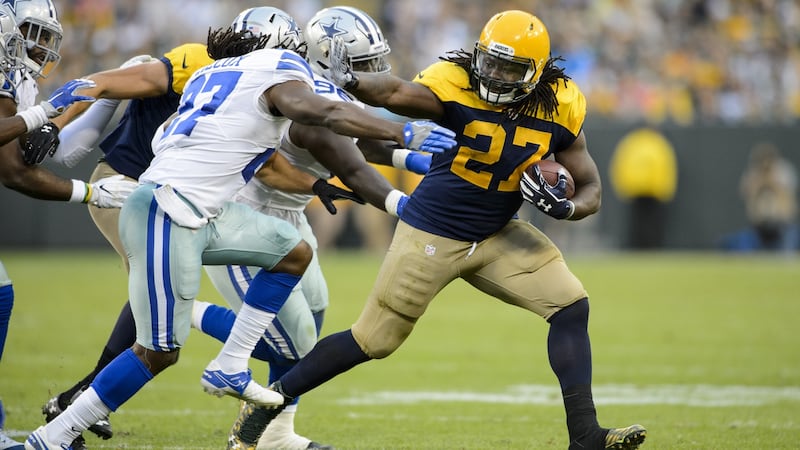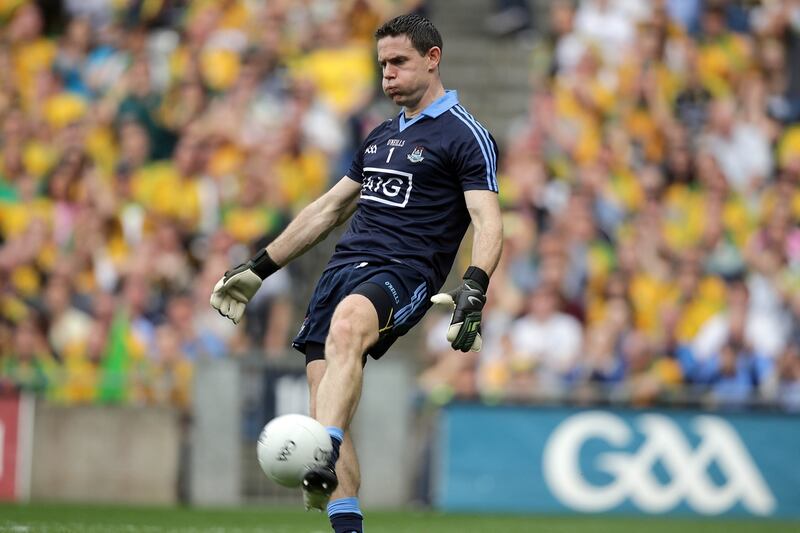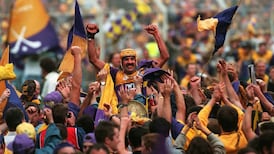Last Monday, the Seattle Seahawks paid their new running-back Eddie Lacy $55,000 for weighing less than 255lb – just under 18½ stone. Next month, they'll weigh him again and if he gets down below 250lb, he gets another $55k. He has seven of these weight incentives built into his contract, aimed at having him below 245lb by the time the season starts in September and keeping him at that weight through the winter.
I was reading all this with my mouth open. Here’s a guy who was a star running-back for Alabama in college and who was great in his first two seasons with the Green Bay Packers. He has real talent but he hasn’t been able to keep himself in good enough shape for the past two seasons to make the best of it. And now he needs a contract incentive to make a decent weight.
Reading that, I was just baffled.

How can an elite athlete with all these great opportunities ahead of him allow this sort of thing to become an issue? Is he not embarrassed? Even if he’s happy with being financially set up for life already, how can he let something as important as his fitness slip like that?
When I hear of money in sport and big contracts, it always makes me think of my time in Miami, with the Toughest Trade TV show. There I got to swap sports and lifestyles with a professional athlete Brian Schneider of the Miami Marlins for a week. In 2015, the team's star player Giancarlo Stanton signed the biggest contract in the history of US sport – $325 million dollars over 13 years.
I was lucky enough to meet Giancarlo and this guy definitely did not struggle with his weight. He was a specimen to behold. He carried an aura around the place, a presence to match his mega-millions contract. I didn’t know of him before I got there but I could even tell just by the way he walked around the place that he was the big dog in the club. He was every inch an elite athlete.
So here are two athletes, both with riches to set them up for the rest of their days. High-profile players, in the prime of their lives, with the ability to go and achieve their goals. One goes one way, the other goes another. Money is obviously a factor but not the biggest one. It all depends on the person in the end.
Body fat
I’d love to sit down with Eddie Lacy and pick his brain. How did it get to this? How is it possible to get so far detached from what you know is the right way to do things? Is it pressure? Are there other factors? How come you’ll do it for a $55k clause in a contract and not for the $1.1m-a-year you were on in Green Bay?
I'm fascinated with what motivates these guys. In the GAA, we obviously don't have money dangled in front of us but we still have to find that motivation. When I played for Kilkenny my weight was sometimes an issue, as it was with other players. In January, it would have been a regular scenario where a conversation would be needed with Noreen Roche, our dietician. Sometimes, Brian Cody would be involved. My body fat would be around 16 per cent and it would be a case of needing it to be at 12 per cent or lower by mid-March or so.
The level of science and planning that went into our nutrition sky-rocketed over the course of my career. When I came in initially in 2003, we were still eating a big fry regularly enough. We started drinking Lucozade Sport and we thought we were at the cutting edge of things. We were weighed maybe once every two or three months. It wasn’t a weight-management thing, it was more of a gesture towards doing the right thing. But the science or education wasn’t all that developed at that stage.
It was 2005-06 when all that started to come in. Weights were introduced. We did screening pre-season. Body fat measurements, weight monitoring, all that side of it started being taken much more seriously.
And then in 2011-12, it really took off. Weekly weights. Urine samples. Dexa scans every six weeks where we’d go down to Waterford IT and lie on this bed for eight minutes as the arm of this scanning machine went over our whole body and measured muscle mass, BMI and body-fat percentage.
Like most GAA players, January was head-down time for me. Get the slog and the long running done, be very strict on my diet. I used make my girlfriend keep any chocolate in the house upstairs so that I wouldn’t see it. I didn’t mind her eating it in front of me – I’m not a psychopath – but I just didn’t want it sitting around the kitchen so that I’d be tempted.
Come February or early March, my weight would realign. I liked doing the work, in a way. I always had the summer months in the back of mind when things got hard in a wet heavy pitch in St Kieran's College. My motto was I couldn't afford to be carrying any extra pounds running around after Lar Corbett or Damien Hayes later on in the season. I knew that I had to hit late spring with my body fat down around 11 per cent and then keep it steady after that. Get a target, hit a target, maintain it.
Enough fluids
By the summer, we were getting weighed purely to make sure we weren’t losing pounds. We would get emails during a spell of good weather to remind us to hydrate properly and to stay in the shade. Noreen would tell us to add an extra 500ml to the usual 3,300ml daily water intake. A two per cent drop in hydration is when performance starts being affected – we had to make sure it didn’t happen.
It was forensic at this stage – weigh in before training, weigh out after. If the weather was especially good, you could lose serious weight in a session or in a match. She’d often be giving out to me because I wasn’t taking enough fluids on board during a game and I’d be shedding way too many pounds. I lost half a stone when we played Tipperary in the 2013 qualifier in Nowlan Park, for example.
It was a matter of constant monitoring. At any random point of the day, my brain would have been ticking away. Am I drinking enough water? How much have I in my system so far? Will the urine sample I give later on be the right colour? How much sugar is in that yoghurt? What time is it? Training is at 7 – I need to eat by 4.30. Shit, that meeting ran on, it’s 5.20 – too late to eat? No, can’t miss it. I’ll eat it but my legs are going to be so heavy when I do the warm-up. Must make sure not to miss that window again.
I got into habits. Breakfast at 8am, lunch at 1pm, constant snacking every two hours in between. If I was having a salad for lunch, I’d make it up the night before and put it in the fridge so I’d only have to grab it and go in the morning. I’d grab four bits of fruit and some nuts for the car. I knew what I needed to eat every day, I was pretty consistent in my routine.
A routine basket shop should take any normal person 10 minutes. But I’d be there checking sodium levels and saturated fat levels on the back of food packets in supermarkets and it could end up taking me double that time. I often felt people were looking at me funny. If I was starting to get self-conscious about it, I’d tell myself that the Tipp lads were doing the same thing in the supermarkets they were shopping in. I don’t know if they were or not but I told myself they were.
I would build in treat days once every two or three weeks. I always allowed myself a pizza and wedges for the Superbowl, a big bag of pick-n-mix on Paddy’s Day. Even reading that now it sounds a bit extreme but when you get into the routine of it, it just becomes second nature. You don’t miss these things because you get to the point where you hardly ever think about it.
The thing to realise about it all though is that even when it was a chore, it never occurred to me not to do it. My attitude was that it was the very least you had to do to be able to survive at inter-county level. I relished the idea of doing all this so that when the summer came around, I was going into the championship with a hard, strong body.
Right shape
It was great to feel lean in June and July, to have Noreen saying, “That’s fine now Jackie, don’t be losing any more weight and make sure and eat enough to keep it up to where it is”.
And it was great to go to training or be in a game and get that feeling of riding a big tackle or taking a big hit and feeling it ping in your brain that all the stuff you’d been doing for six months had you where you wanted to be.
That’s one of the things I just can’t fathom about Eddie Lacy. Running back is the most attritional position in American football. The average length of an NFL running back career is two-and-a-half seasons – the shortest of any position. They get absolutely pummelled. If Lacy can’t be bothered for the good of the team, surely self-preservation alone should get him into the right shape for battle.
But I guess it comes back to motivation. I think of Giancarlo Stanton and what motivates him. Massive contract, huge profile, numerous sponsorship deals, millions made already, millions more to come. So what makes him tick?
I come to the conclusion that it’s the very same thing that makes an All-Ireland-winning hurler tick. It’s aspiring to be the best version of yourself. We all go different ways and have different opportunities. We all have challenges and perceived obstacles. Finding your way depends on you, what you’re willing to do, what gets you going.
And look, maybe that’s seven instalments of $55,000. Maybe Eddie will lay off the McDonald's and be the running back that the Seahawks need him to be in 2017. He hit his number first time around, maybe he’ll keep hitting them and stick it to the doubters and the people who are sneering at him.
And maybe I am just jealous that he is 27 and in his prime!














